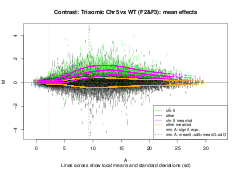Research
MAQC Consortium 2011–2014 (read more)
FDA SEQC, Nature Biotechnology (read more)
Bioinformatics (read more)
FEBS Journal (read more)
Gerontology (read more)
 Most plants and animals have two copies of each chromosome in
the normal chromosome set. Unbalanced numerical changes
resulting from gains or losses of individual chromosomes
(aneuploidy) usually have deleterious consequences. For
example, Down syndrome in humans is caused by an extra
(triplicate) copy of chromosome 21. Human tumor cells usually
display numerous alterations in chromosome number and
structure. Little is known about how changes in chromosome
number influence gene activity and chromosome integrity,
thereby perturbing physiology and development.
The current literature, moreover, seems to be divided regarding the
question whether in an organism with an extra chromosome most
of the genes on the extra chromosome reflect the dosage
Most plants and animals have two copies of each chromosome in
the normal chromosome set. Unbalanced numerical changes
resulting from gains or losses of individual chromosomes
(aneuploidy) usually have deleterious consequences. For
example, Down syndrome in humans is caused by an extra
(triplicate) copy of chromosome 21. Human tumor cells usually
display numerous alterations in chromosome number and
structure. Little is known about how changes in chromosome
number influence gene activity and chromosome integrity,
thereby perturbing physiology and development.
The current literature, moreover, seems to be divided regarding the
question whether in an organism with an extra chromosome most
of the genes on the extra chromosome reflect the dosage
 increase. In such assessments, classical analyses face the
problem that a large number of genes change in an asymmetric
way, invalidating most commonly used normalization
approaches. Using appropriate transforms, however, we could
show in Huettel et al. (2008) that most genes indeed reflect
the dosage increase, with only a small percentage being
regulated differentially from this trend.
increase. In such assessments, classical analyses face the
problem that a large number of genes change in an asymmetric
way, invalidating most commonly used normalization
approaches. Using appropriate transforms, however, we could
show in Huettel et al. (2008) that most genes indeed reflect
the dosage increase, with only a small percentage being
regulated differentially from this trend.
References
- Huettel B,* Kreil DP,* Matzke M, Matzke AJ (2008) Effects of aneuploidy on genome structure, expression, and interphase organization in Arabidopsis thaliana. PLoS Genet. 4, e1000226. (read more | Supplement)
- Kanno T, Bucher E, Daxinger L, Huettel B, B�hmdorfer G, Gregor W, Kreil DP, Matzke M, Matzke AJ (2008) A structural-maintenance-of-chromosomes hinge domain-containing protein is required for RNA-directed DNA methylation. Nat Genet. 40, 670–5 (preprint on request)
Return to group home or publications


